I spent 16 days on holiday in India and Singapore from 24 October to 8 November 2018. India is a colourful interesting place, bustling with people. Spiritual and mysterious. Sacred and smelly. Noisy and peaceful. So many contrasts. I found the people are generous, friendly and family oriented. Wifi and internet speed is wonderful.
We explored the “Golden Triangle” – Delhi, Jaipur and Agra. Which covered a small part of the huge desert state of Rajasthan. We arrived in New Delhi, flew to Udaipur and spent 2 days in the beautiful city, and only one night in tiny Ranakpur, 2 days in the town of Pushkar (see Part 1); 3 days in Jaipur city (see Part 2). We drove to Agra and stayed there for 3 days and spent the last 2 days in New Delhi (Part 3). After my India trip I spent 2 days and one night in Singapore on the way back to Australia. (see Part 4).
Jaipur to Agra
After a late start on 2nd November we had a long drive from Jaipur to Agra. We were using IST = Indian Stretchable time! It was a long day. We visited the Galataji Monkey Temple, Fatehpur Sikri Palace and Mosque on the way.
Galataji Monkey Temple in Aravali Hills
Galtaji is an ancient Hindu pilgrimage about 10 km away from Jaipur, in the Indian state of Rajasthan. The site consists of a series of temples built into a narrow crevice in the ring of hills that surrounds Jaipur. A natural spring emerges high on the hill and flows downward, filling a series of sacred kunds (water tanks) in which pilgrims bathe. Visitors and pilgrims can ascend the crevasse, continuing past the highest water pool to a hilltop temple from there are views of Jaipur and its fortifications spreads out across the valley floor. It is believed that a Saint named Galav lived here, practiced meditation, and did penance (tapasya). (Wikipedia)
At this monkey temple we were told that there are 3 ponds: bottom one for monkeys, second one is for women, and the top for men – a cow mouth spring. They don’t know where water comes from.
It was a disappointing rushed visit because we saw only 2 monkeys and were told we didn’t have enough time to visit the top pond and sacred spring or see the views of Jaipur. However I found a building with a Shiva Lingam Yoni and I did my private meditation.G
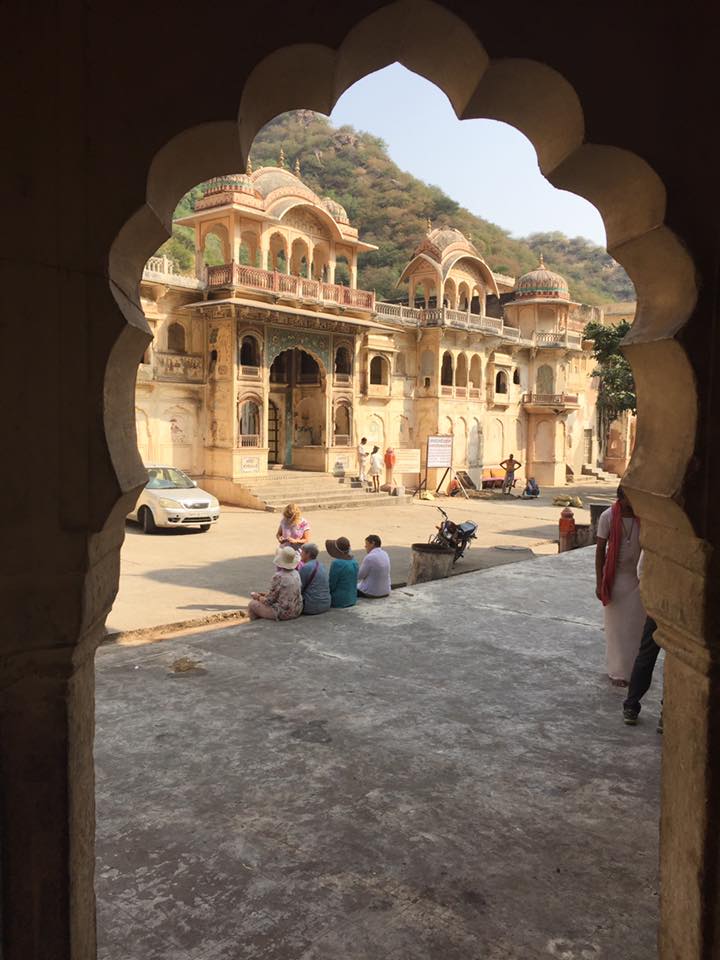
Monkey Temple 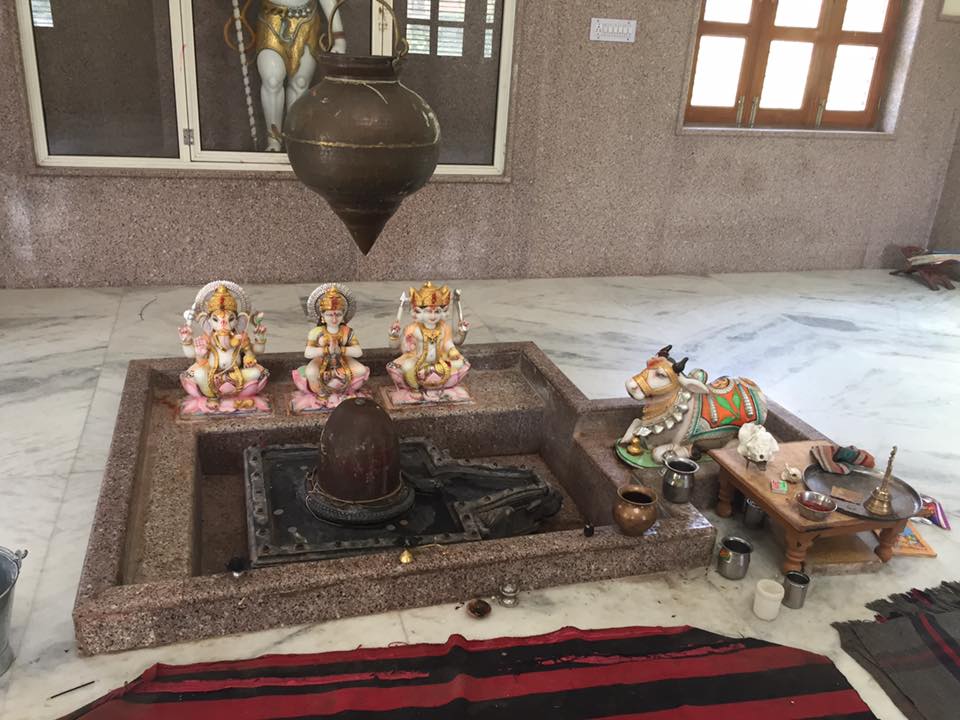
Shiva Lingam Yoni Temple
Fatehpur Sikri
“The city of Fatehpur Sikri was founded in 1571 and was named after the village of Sikri which occupied the spot before. The Buland Darwaza was built in honor of his successful campaign in Gujarat, when the city came to be known as Fatehpur Sikri – “The City of Victory”. It was abandoned by Akbar in 1585 when he went to fight a campaign in Punjab. It was later completely abandoned by 1610. The reason for its abandonment is usually given as the failure of the water supply, though Akbar’s loss of interest may also have been the reason since it was built solely on his whim.
Akbar visited the city only once in 1601 after abandoning it. William Finch, visiting it 4–5 years after his death, stated, “It is all ruinate,” writing, “lying like a waste desert.” During the epidemic of bubonic plague from 1616-1624, Jahangir stayed for three months here in 1619. Muhammad Shah stayed here for some time and the repair works were started again. However, with the decline of Mughal empire, the conditions of the buildings worsened.”(Wikipedia)
Fatehpūr Sikrī Palace
We were told the Fatehpur Sikri Palace was called the Ghost Palace because it was only inhabited for a few years and then abandoned because the water supply was not suitable.
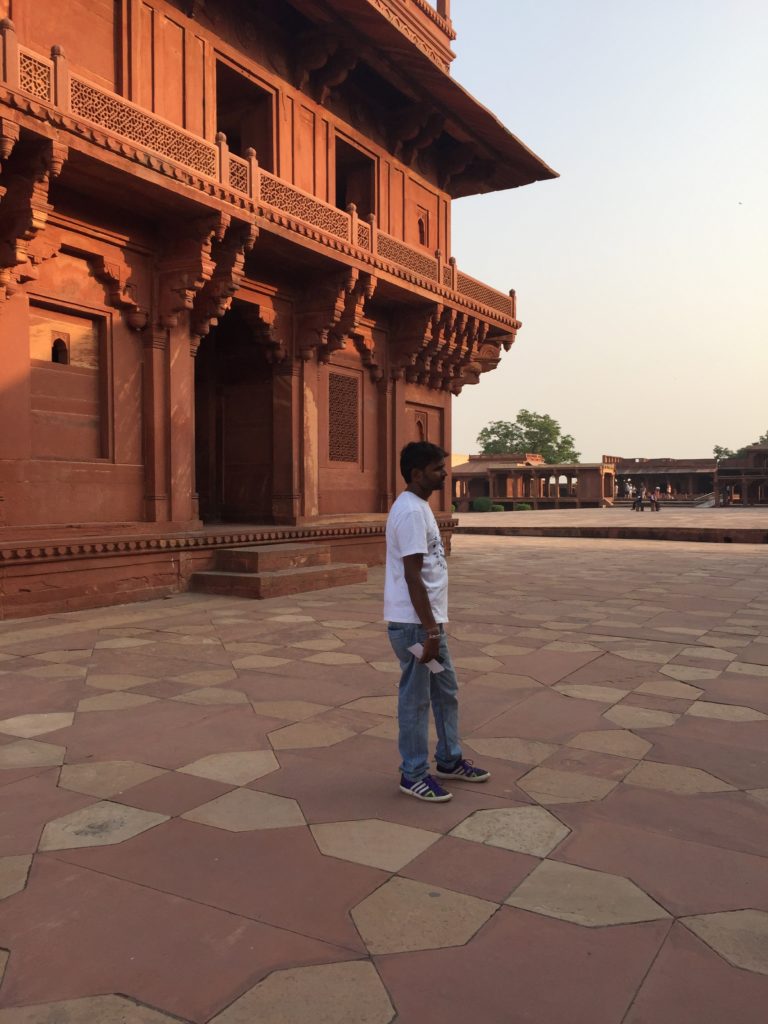
Raju at Fatehpur Sikri Palace 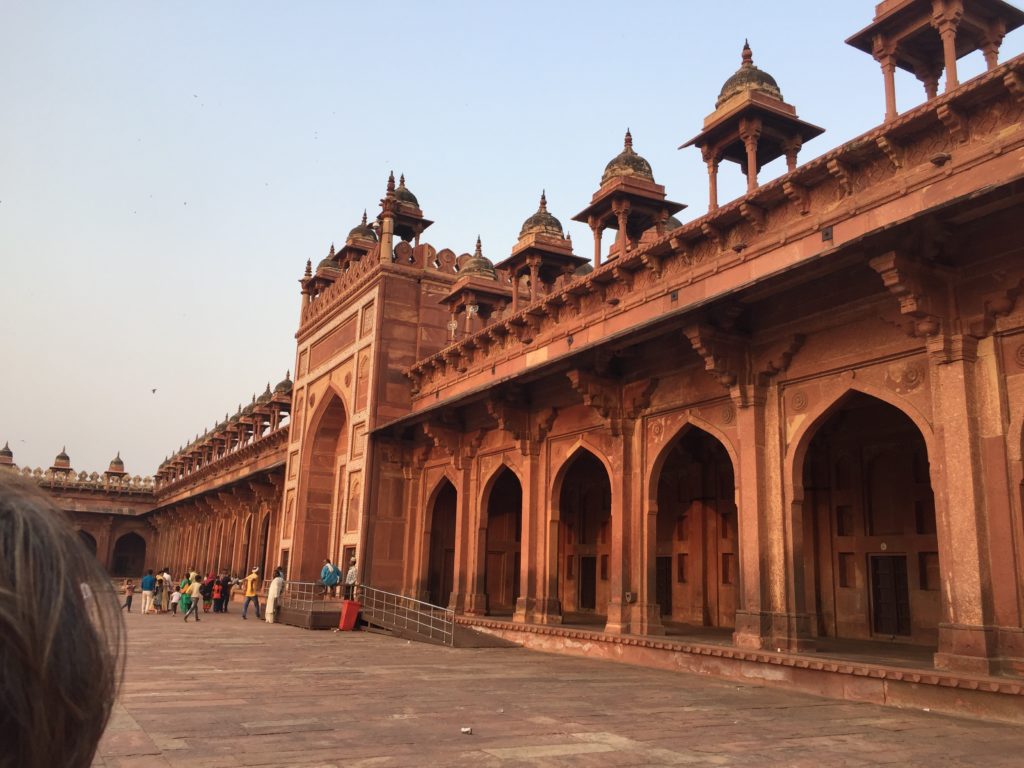
Fatehpur Sikri Palace 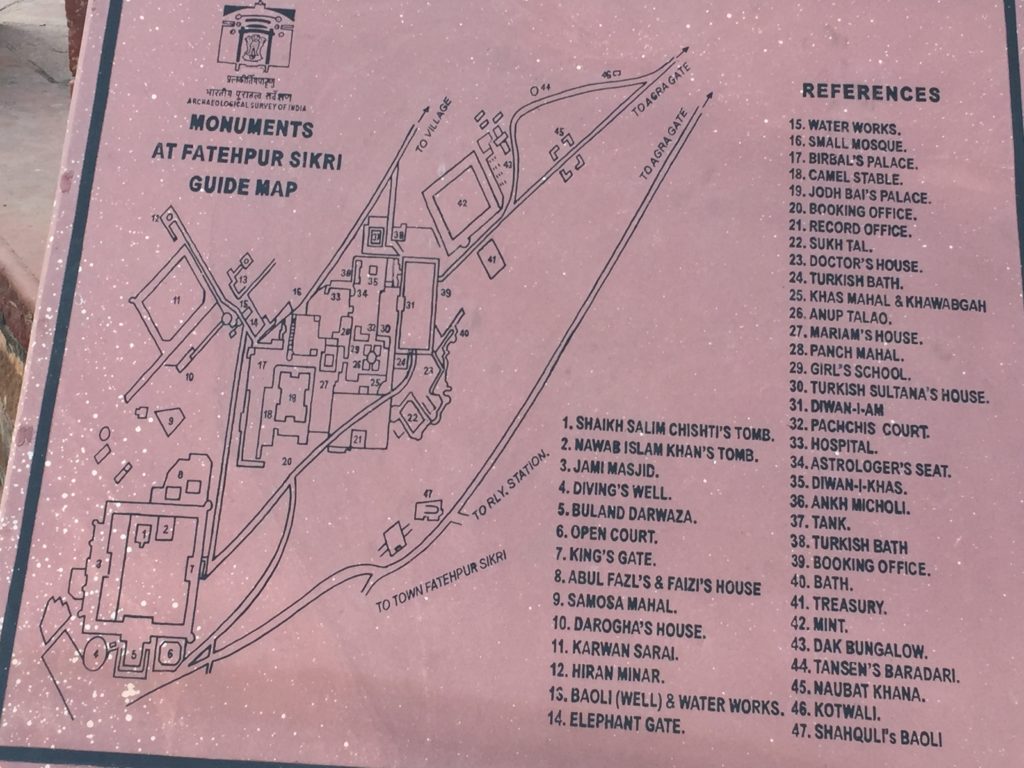
map of FS palace and mosque
Fatehpūr Sikrī mosque
“The Jama Masjid (Friday Mosque) is a 17th-century mosque in the World Heritage Site of Fatehpur Sikri in India. The Mughal emperor Akbar personally directed the building of the Jāmiʿ Masjid (Great Mosque; 1571), which stretches some 540 feet (165 metres) in length. The mosque also known as the “Friday Mosque” is one of the largest mosques in India and is a most sought after pilgrimage site by the devotees. It is also one of the most visited tourist destinations in Agra district. Some of the designs of the mosque reflect beautiful Iranian architecture.” (Wikipedia)
We got there at sunset and were warned we would be accosted by touts. They were very insistent and we had to try to ignore them. I didn’t like the energy of this mosque at all.
The only part I thought was interesting was a “secret” tunnel entrance (built in about 1500) which was wide and big enough to take 2 horses and escape to Agra Fort! (which is about 37km away)
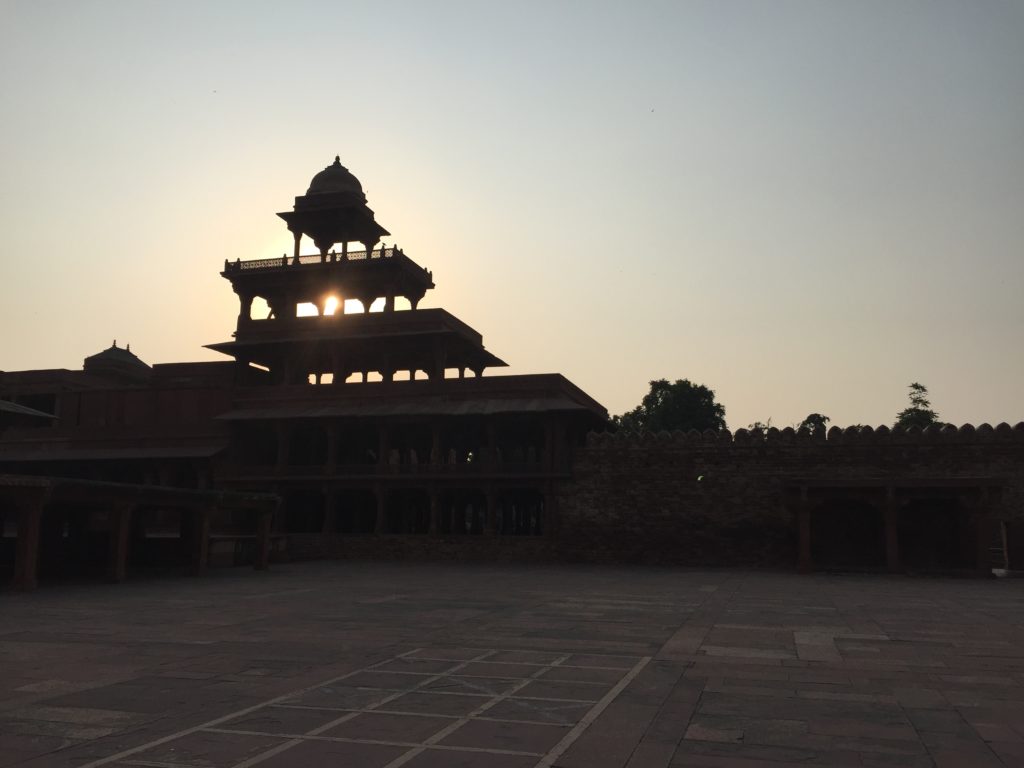
Fatehpur Sikri mosque at sunset 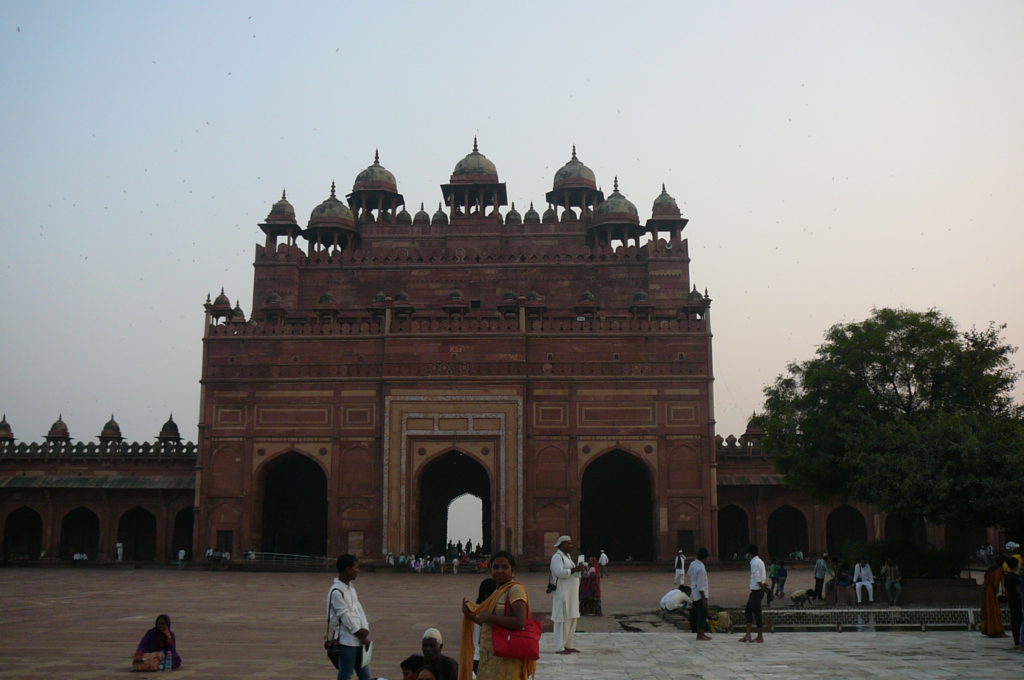
Fatehpur Sikri mosque
Agra
“Agra is a city on the banks of the river Yamuna in the northern state of Uttar Pradesh, India. It is 239 kilometres from Jaipur and 206 kilometres (128 mi) south of the national capital New Delhi. Agra is one of the most populous cities in Uttar Pradesh, and the 24th most populous in India.
Because of its many Mughal-era buildings, most notably the Tāj Mahal, Agra Fort and Fatehpūr Sikrī, all of which are UNESCO World Heritage Sites. Agra is included on the Golden Triangle tourist circuit, along with Delhi and Jaipur; and the Uttar Pradesh Heritage Arc, tourist circuit of UP state, along Lucknow and Varanasi. It has a population of about 4 million people” (Wikipedia)
Agra Carpet Factory
On Wed 3rd November we toured around Agra – first to the carpet factory, and then to Agra Fort, and to the back of the Taj Mahal at sunset.
We saw a handmade Carpet making demonstration. The wool carpets are 100% handmade, using a pattern for size and quality. A handmade carpet size 48 x 72 takes about 5 months approximately to make! The carpet weaver gets paid monthly by square metre he has made. They burn the back of the carpet so it doesn’t slip on the floor. They wash it as well, and then cut the top of the carpet to sharpen the lines to make pattern pop up. We had a Carpet showing – Pashmina throws, many carpets, Silk on silk, wool. Handmade carpets (rugs) are a different colour from different directions!! You can clean handmade wool carpets with soap and water. Quote from carpet man: “Women don’t make mistakes only men make mistakes!!”
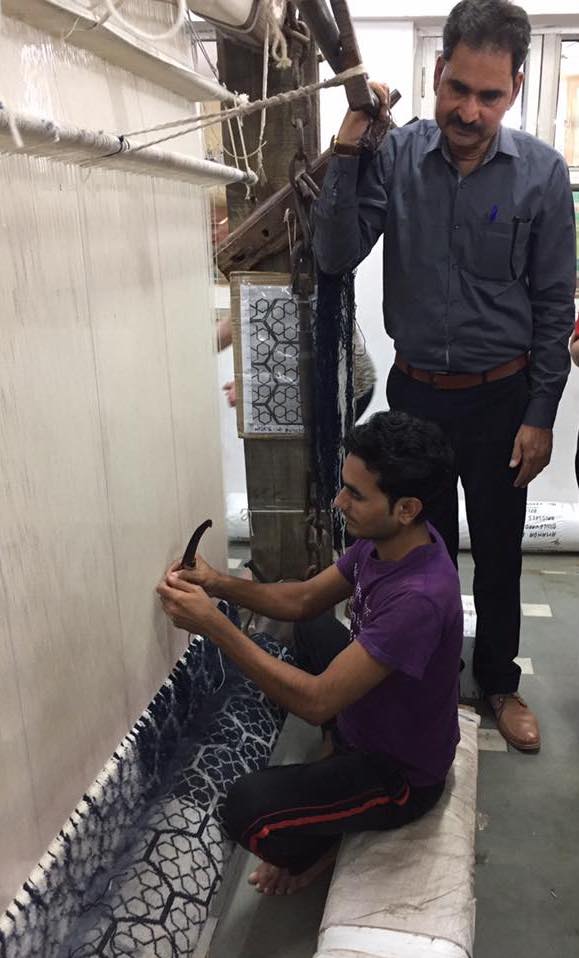
each knot is hand tied! 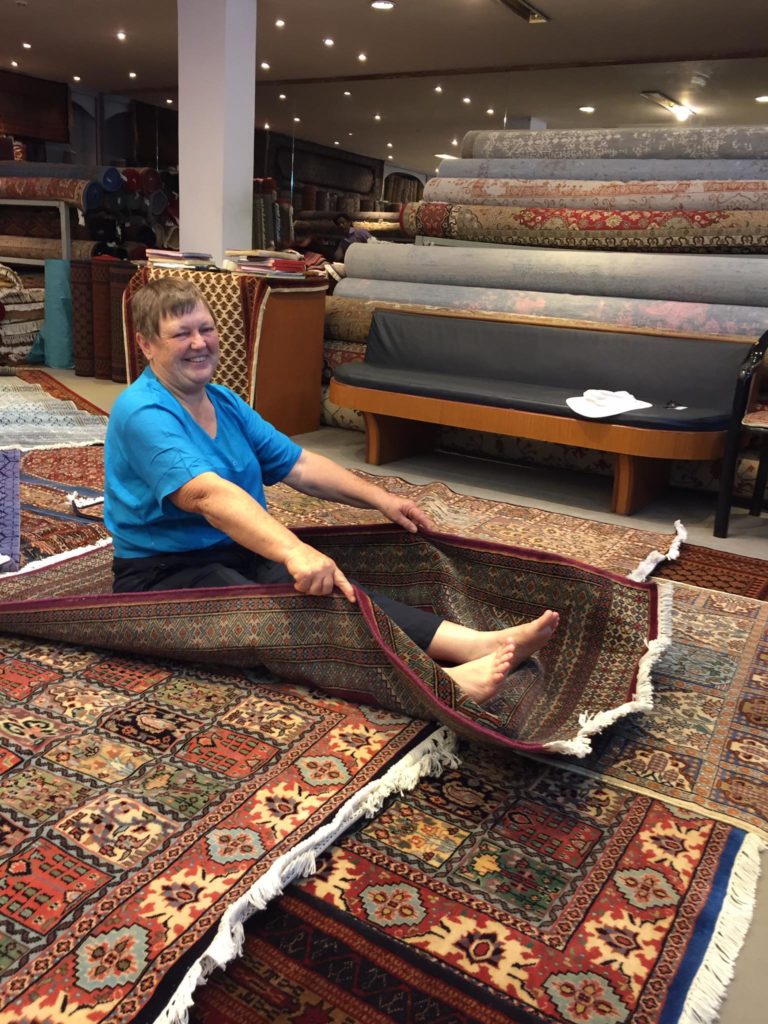
magic carpet ride
Agra Fort
“Agra Fort is a historical fort in the city of Agra in India. It was the main residence of the emperors of the Mughal Dynasty until 1638, when the capital was shifted from Agra to Delhi. It is about 2.5 km northwest of its more famous sister monument, the Taj Mahal. The fort can be more accurately described as a walled city.” (Wikipedia)
We were told that Agra Fort was built before Taj in1739. It took 95 years to build it. There are 4 gates – Elephant gate, Water gate, West gate, and Delhi gate. At the entrance to the fort there are grooves for horseshoes so the horses don’t slip.
We also went to the gardens across the river at the back of the Taj Mahal to take photos at sunset. It looks the same from front or back!
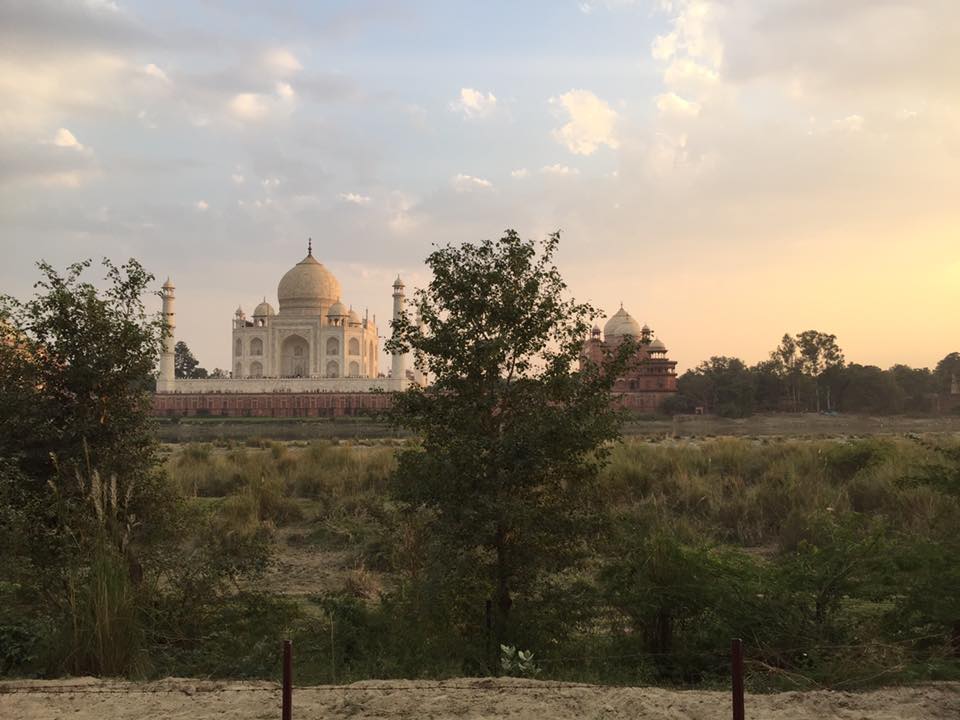
Taj Mahal visit
We got up at 5am, had no breakfast, but bananas and water were provided. At 5:30am we got on bus to Taj Mahal and it was still dark! It was very cold until the sun came up. We took lots of photos of the Taj Mahal. There were lots of people.
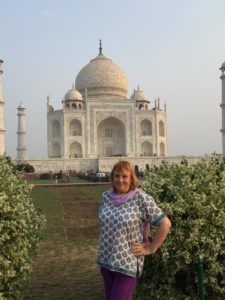
“The Taj Mahal (meaning “Crown of the Palaces”) is an ivory-white marble mausoleum on the south bank of the Yamuna river in the Indian city of Agra. It was commissioned in 1632 by the Mughal emperor, Shah Jahan (reigned from 1628 to 1658), to house the tomb of his favourite wife, Mumtaz Mahal. It also houses the tomb of Shah Jahan, the builder. The tomb is the centerpiece of a 17-hectare (42-acre) complex, which includes a mosque and a guest house, and is set in formal gardens bounded on three sides by a crenellated wall.
The Taj Mahal was commissioned by Shah Jahan in 1631, to be built in the memory of his wife Mumtaz Mahal, a Persian princess who died giving birth to their 14th child, Gauhara Begum. Construction started in 1632, and the mausoleum was completed in 1643, while the surrounding buildings and garden were finished five years later. The imperial court documenting Shah Jahan’s grief after the death of Mumtaz Mahal illustrates the love story held as the inspiration for the Taj Mahal.
The exterior decorations of the Taj Mahal are among the finest in Mughal architecture. As the surface area changes, the decorations are refined proportionally. The decorative elements were created by applying paint, stucco, stone inlays or carvings. In line with the Islamic prohibition against the use of anthropomorphic forms, the decorative elements can be grouped into either calligraphy, abstract forms or vegetative motifs. Throughout the complex are passages from the Qur’an that comprise some of the decorative elements.
The calligraphy on the Great Gate reads “O Soul, thou art at rest. Return to the Lord at peace with Him, and He at peace with you.”
Much of the calligraphy is composed of florid thuluth script made of jasper or black marble inlaid in white marble panels. Higher panels are written in slightly larger script to reduce the skewing effect when viewed from below. The calligraphy found on the marble cenotaphs in the tomb is particularly detailed and delicate The Taj Mahal was constructed using materials from all over India and Asia. It is believed over 1,000 elephants were used to transport building materials. It took efforts from 22,000 labourer, painters, embroidery artists and stonecutters to shape the Taj Mahal. The translucent white marble was brought from Makrana, Rajasthan, the jasper from Punjab, jade and crystal from China. The turquoise was from Tibet and the Lapis lazuli from Afghanistan, while the sapphires came from Sri Lanka and the carnelian from Arabia. In all, 28 types of precious and semi-precious stones were inlaid into the white marble.
Soon after the Taj Mahal’s completion, Shah Jahan was deposed by his son Aurangzeb and put under house arrest at nearby Agra Fort. Upon Shah Jahan’s death, Aurangzeb buried him in the mausoleum next to his wife.” (WIkipedia)
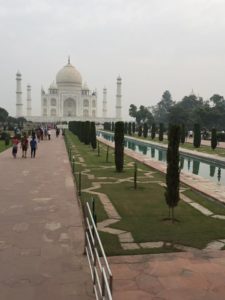
We were told by the Indian Tour Guide the romantic story of Mumtaj, the Persian wife of emperor Shah Jahan, whose mausoleum is the Taj Mahal. When she gave birth to her 14th baby, she got sick and knew she was dying so she asked her husband 3 things:
- Don’t remarry
- Look after our children
- Make a tribute to me better than anyone else has ever seen.
After building it he was imprisoned by his son and when he died 35 years later he was buried there too – underneath.
Facts about the Taj Mahal
- Everything is 100% symmetrical except for Shah Jahan Akbar’s tomb inside.
- The 4 towers are leaning out!! so that if there is an earthquake they don’t damage the Taj Mahal!
- White Marble came from 400 km away!
- It is an octagonal structure, not square!
- The Persian lettering on the pillars are black stone, not painted.
When I felt the energy of Taj Mahal from top of central spire to bottom below ground I felt that it is very powerful strong loving.
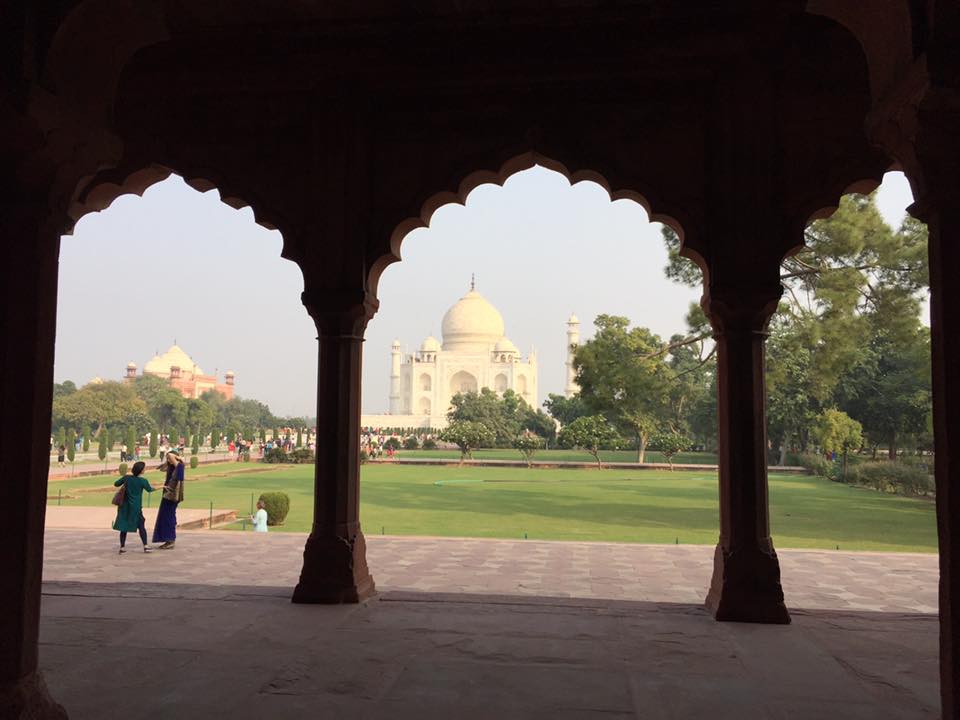
We finally had a delicious breakfast at Bansi at 9am – Paw paw, Sweet lime juice, Sweets, Poori (puffy pancake) and potato stuff, Scrambled eggs.
Tomb of I’timād-ud-Daulah
“Tomb of I’timād-ud-Daulah is a Mughal mausoleum in the city of Agra in the Indian state of Uttar Pradesh. Often described as a “jewel box”, sometimes called the “Baby Taj”, the tomb of I’timād-ud-Daulah is often regarded as a draft of the Taj Mahal. The mausoleum was commissioned by Nur Jahan, the wife of Jahangir, for her father Mirzā Ghiyās Beg, originally a Persian Amir in exile, who had been given the title of I’timād-ud-Daulah (pillar of the state). Mirzā Ghiyās Beg was also the grandfather of Mumtāz Mahāl (originally named Arjumand Bano, daughter of Asaf Khan), the wife of the emperor Shah Jahan, responsible for the construction of the Taj Mahal.” (Wikipedia)
At 10:30 we went by bus to “Baby Taj” – tomb of step father of Shah Jahan built by Nur Jahan for her father.(Nur Jahan = means Light of the world)
We were told it was built in 1622 and took 6 years to build. It was painted inside with vegetable colour, and the outside was inlaid decor. The ceiling was painted with gold. Both her mum and dad are buried here, and I asked if Nur Jahan who built it was buried here. They told me her tomb is in Lahore in Pakistan.
I loved this stunning building. It took my breath away when I first saw it! So beautiful! The photos don’t do it justice.
The energy inside the tomb felt to me very maternal and loving for her parents.
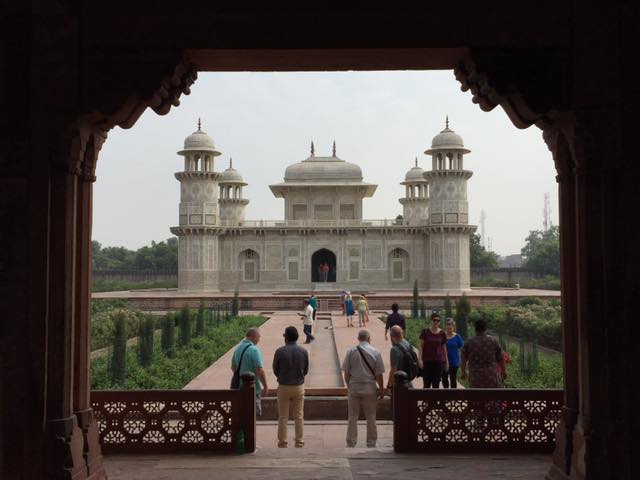
beautiful breath taking Tomb of I’timād-ud-Daulah – inspiration for Taj Mahal 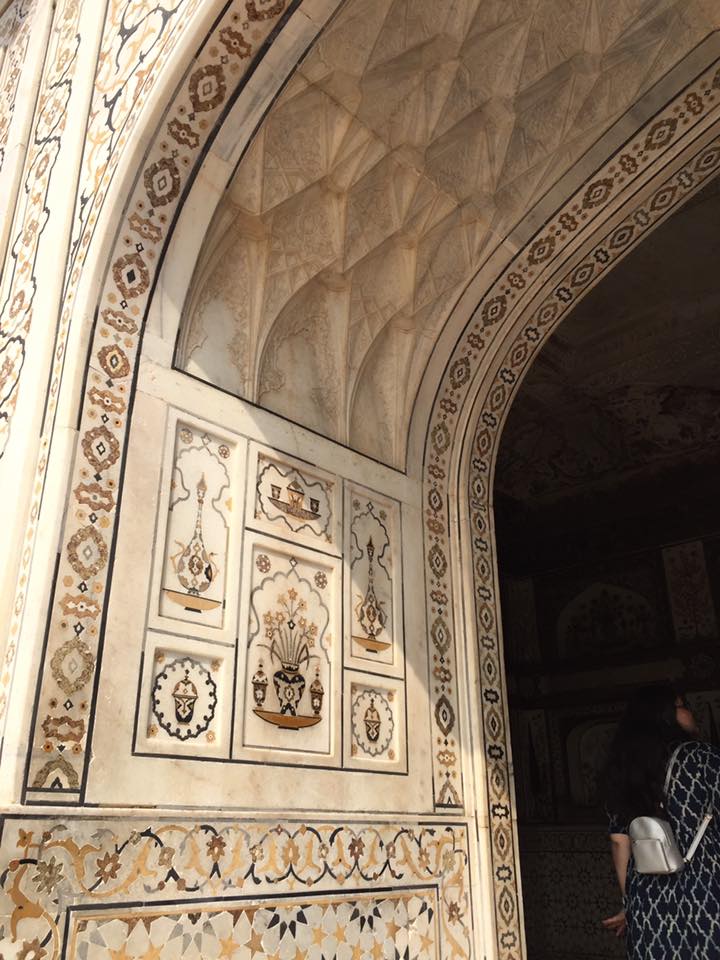
doorway
Agra Marble Shop
Next we visited a working marble shop in Agra. The translucent white marble comes from underground mines near Jaipur.
We saw 4 men doing each aspect of the construction – drawing the design, cutting stones, shaping stones and gluing stones in. They put henna on marble to temporarily colour it to draw the pattern eg draw outline of petal, then scrape a hole 2.5 mm deep to put specially cut stones in. Stones are hand cut and stuck in one by one!! They use a special glue- very hard- melts only once and takes 2 hours to set. Sets dry, then it is sanded and polished.
Precious Stones used: Turquoise from Turkey, Green Malachite from, Jasper from, Mother of pearl glows in sun, Carnelian fire stone glows in dark.
Only Indian marble has translucent property – table tops glow when lit from underneath no matter how thick it is!!
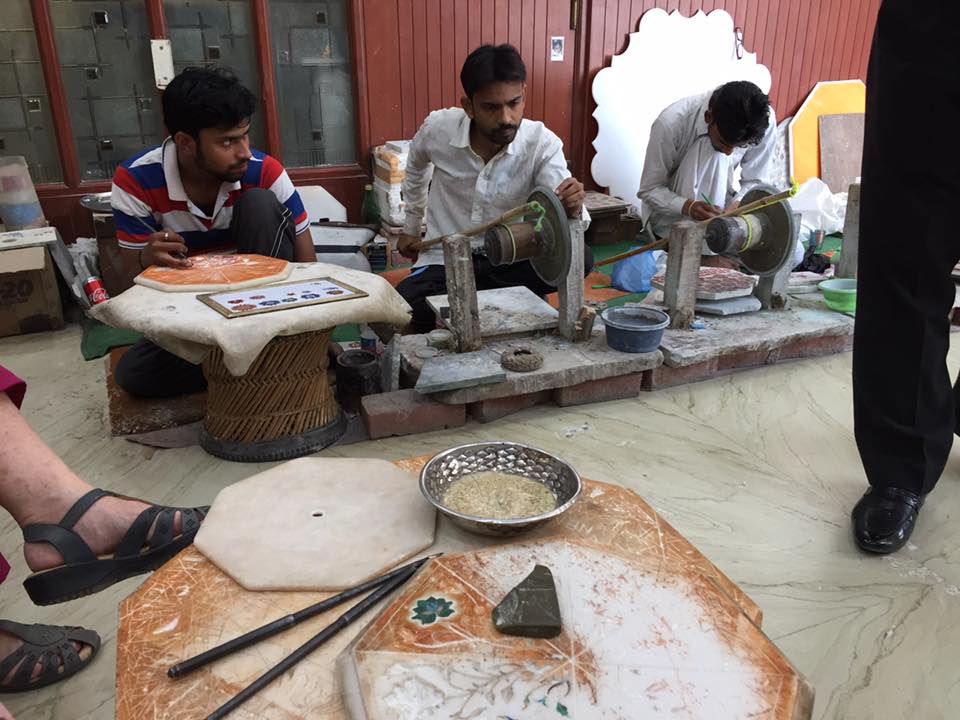
handmade marble table top demonstration 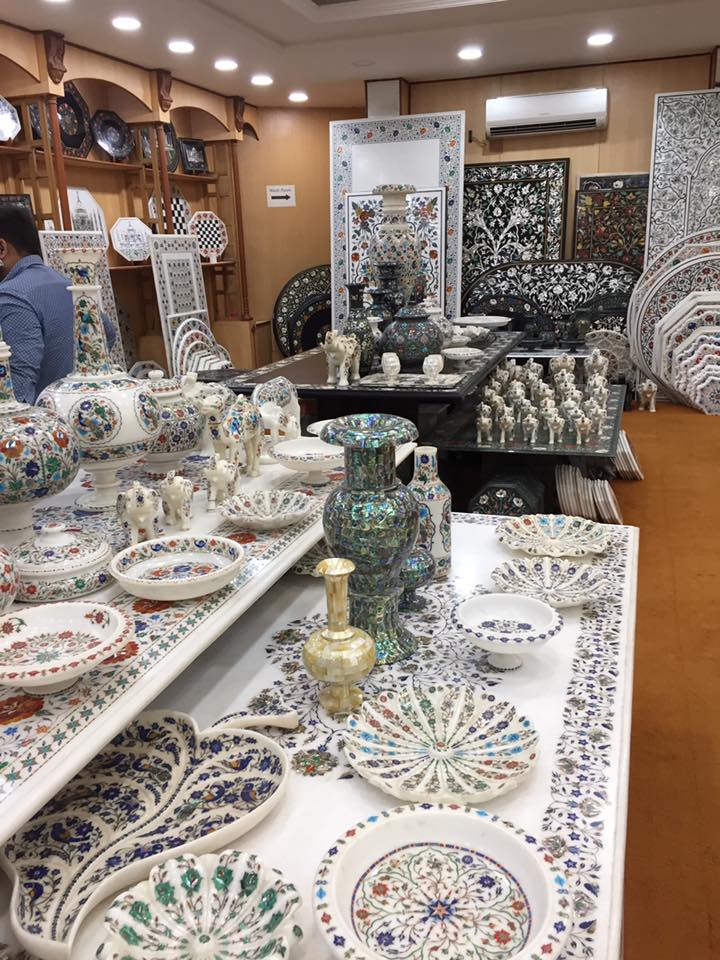
so many beautiful marble items
It takes 45 days for 2 people to make a marble table top. They can be round or octagonal, solid or lattice cut, large, medium or small. The small ones cost about NZ$652 or AU$500, medium size cost 48,000 rupees or about AU$960, depending on the number of stones inlaid. Only takes 25 days to make if less decorative. If you take it with you it is specially wrapped and cheaper too. The number on back of table top is the number of stones. You get a free stand when you buy a table top!
Also available in the shop are a huge range of beautiful marble items of all sizes: round or octagonal coasters, tiles, vases, bowls, platters and ornaments – elephants and other animals.
I wasn’t going to buy anything marble, but I just couldn’t go home without a little marble table! I had a hard time choosing out of all the beautiful table tops – round or hexagonal like Taj? Do I get solid or cut out? Blue or same coloured stones as Taj Mahal? I narrowed it down to four!
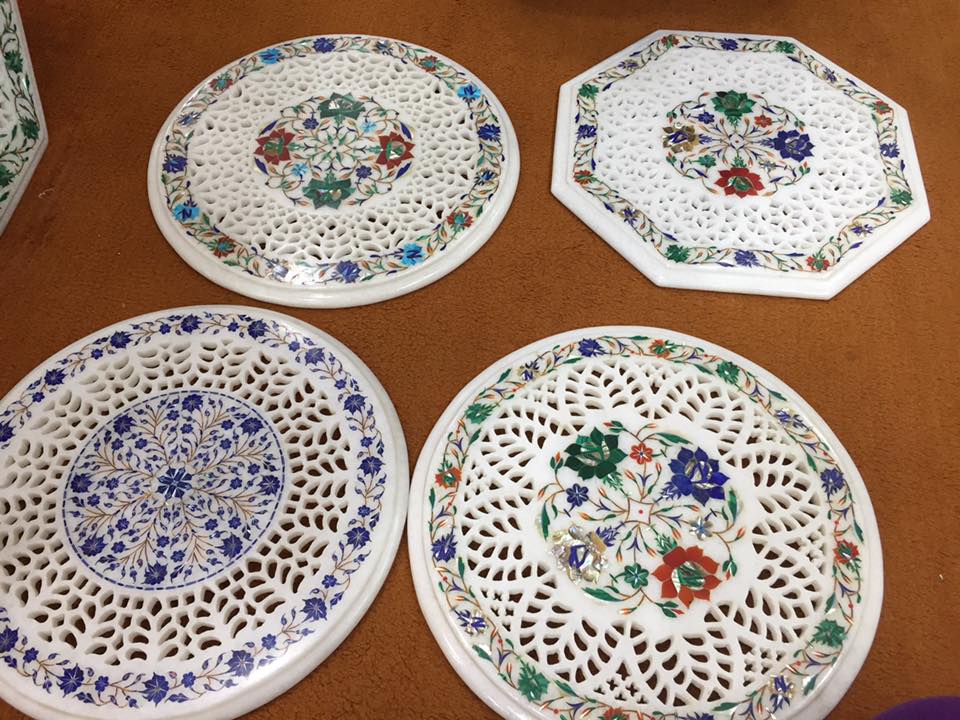
Which marble table top to choose? 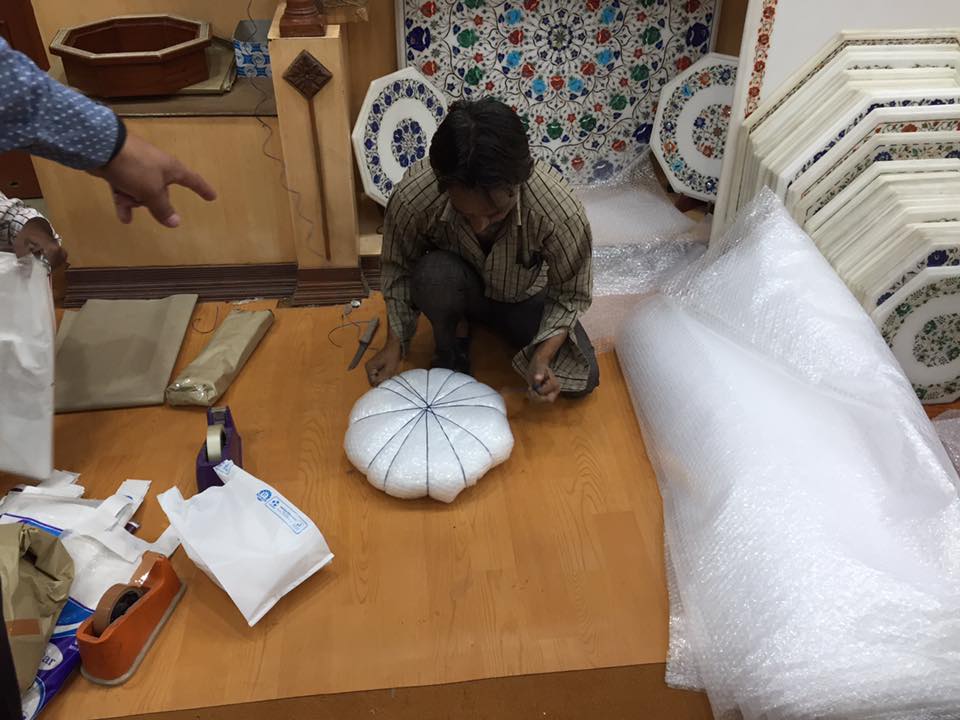
my table top bubble wrapped to take home
At 3pm we went to have a relaxing massage at multi story hotel in Agra. Heena gave me a great massage and head massage. We had an early dinner at Bansi – takeaway KFC!
Agra to New Delhi
On 5 November we had an early breakfast at 6:30am to be on the bus to leave at 7.30am. We were again given lovely gifts from our Indian host, Mr ? of Bansi – a beautiful marble tea light each.
It took us 3-4 hours to drive to New Delhi where the air quality was very polluted and hazy.
Delhi has a population of 23 million – the same population as the whole of Australia!! It is a very polluted city, full of people. Whenever I checked my weather app to see the weather and temperature it said “poor air quality”!
The others checked in to the Hotel Sunstar Heritage and I went to the dentist at the Manav Dental Clinic. Marilyn recommended him as she has had lots of great dental work done over many years by Dr Manish Motihar, BDS. It only cost me 1,000 rupees for X-ray and exam ($20) and 1,000R for a filling! My Root Canal Treatment will be 10,000R ($200) tomorrow [in Australia it would cost nearly AU$2,000!].
More shopping! We visited Kahn Market and looked at the beautiful Diwali lights, Inoki patterned clothes, Fab India clothes and other luxury shops at sunset. We had dinner at Kahn Market – I had mushroom penne pasta. Marilyn gave each of us a DVD. She couldn’t get 10 copies of Jodha Akabh, so I got a DVD called “Kama Sutra”. It was a love story, not the famous book!
The shops were decorated and festooned with lights for Diwali, the Festival of Lights. Lakshmi, goddess of wealth, is goddess of Diwali.
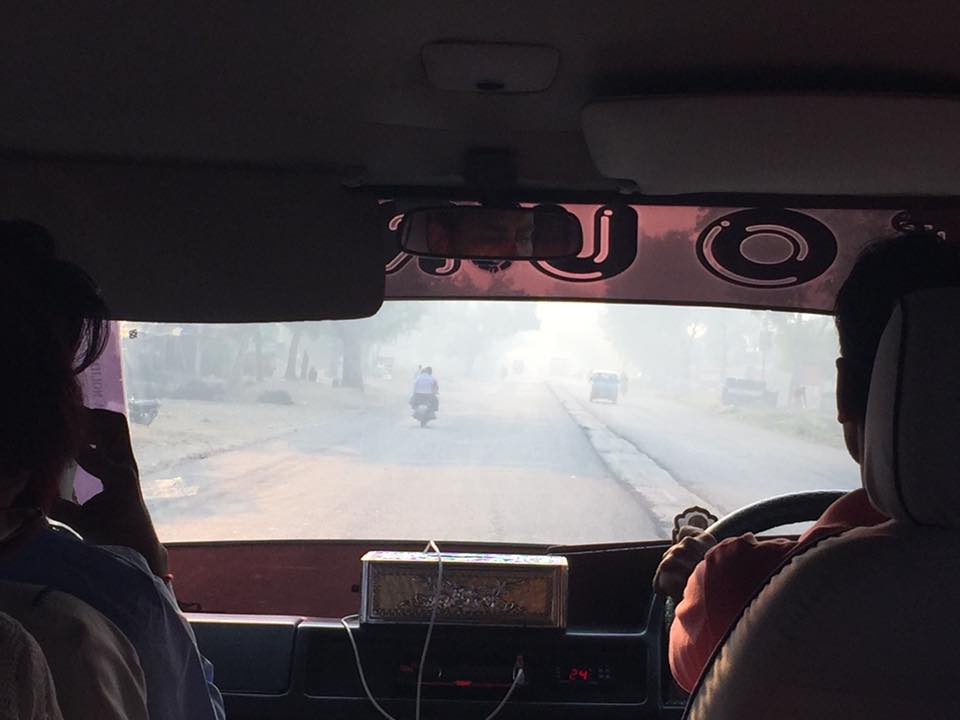
haze of polluted New Delhi 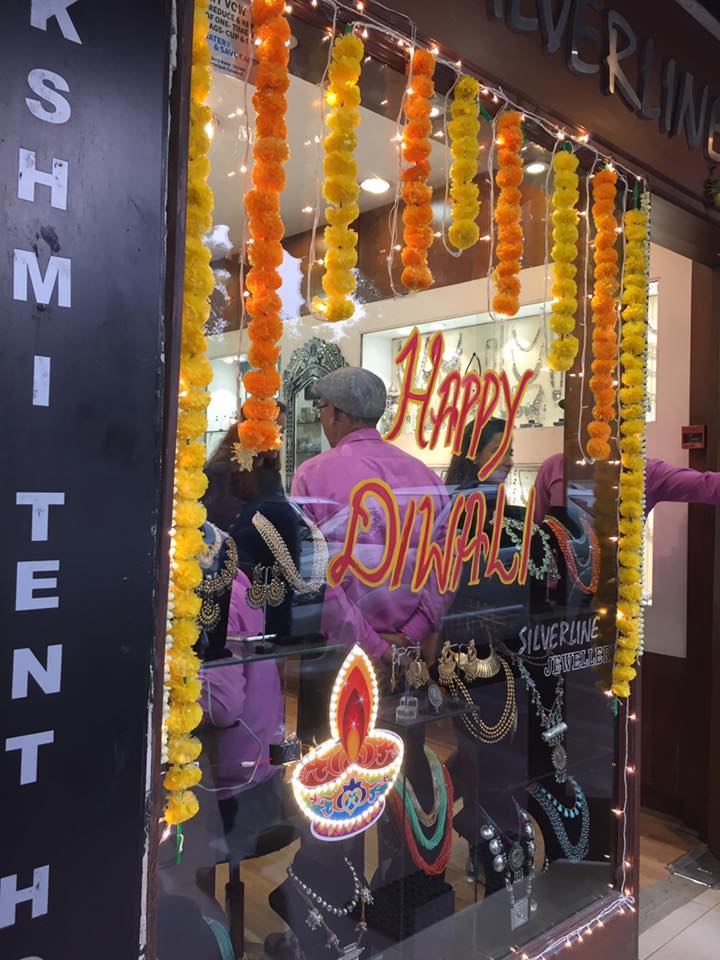
Happy Diwali decor at Kahn Market
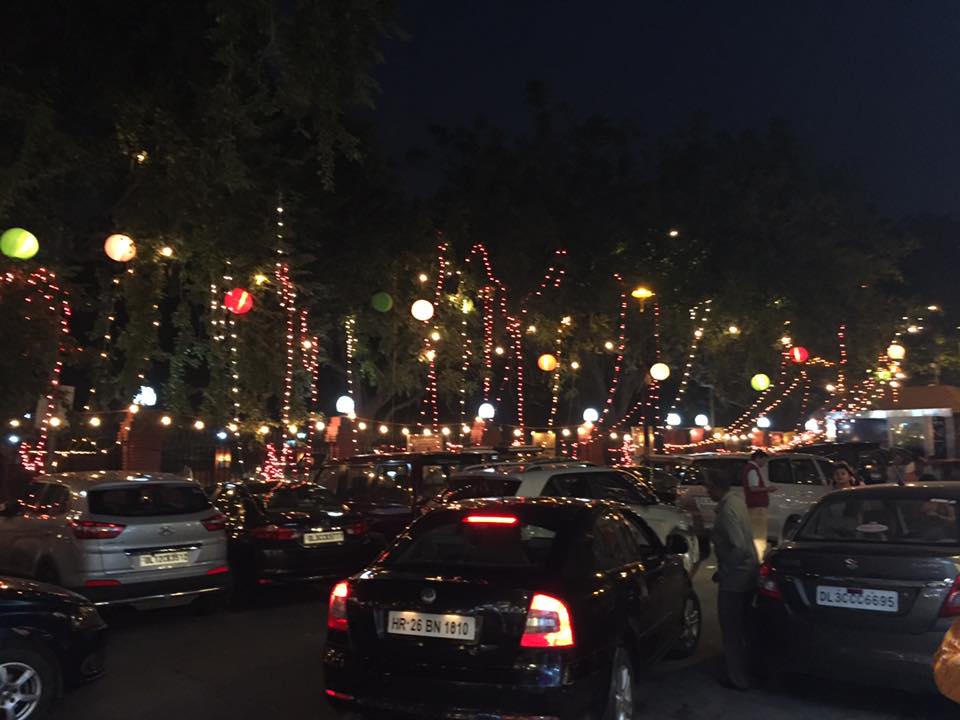
Diwali lights in Delhi 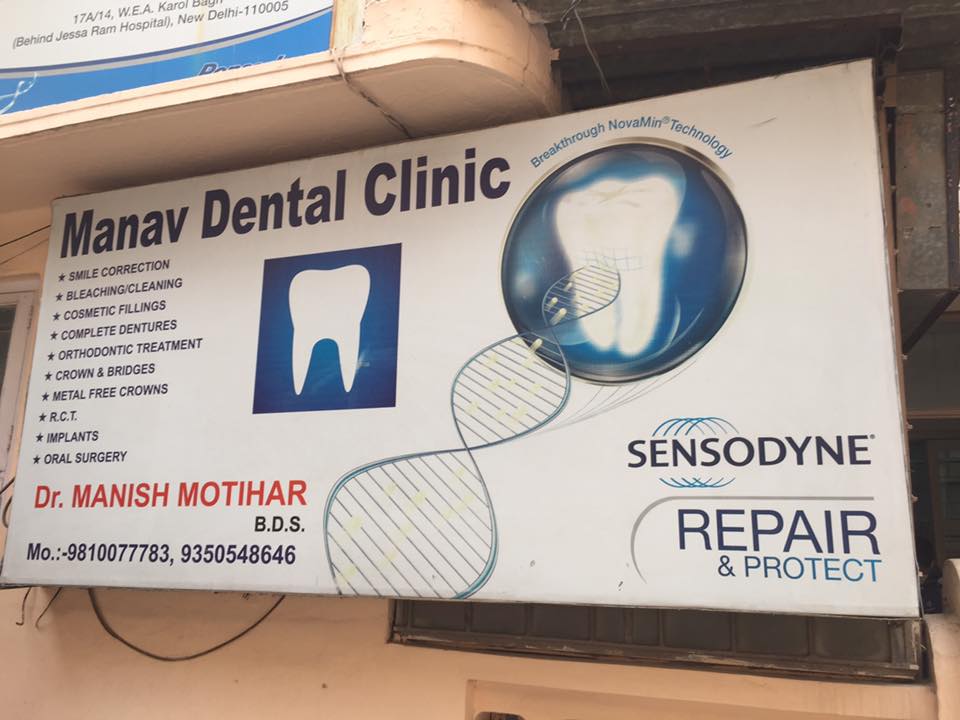
Recommended Dentist – Dr Manish Motihar, Manav Dental Clinic, New Delhi
Delhi
I had my root canal done in the morning. It only took 30 minutes by a root canal specialist – no injection, painless and easy.
Another 10 seater bus was hired for on Tuesday 6 November (Melbourne Cup Day!) for our sight seeing tour to India Gate war memorial. It looked a bit like the Arc De Triumph with 25000 names on it from WW1 & WW2. Then we visited Ghandi’s Smriti – the beautiful house and gardens where Ghandi lived last 144 days until he was assassinated. It was a museum as well with lots of information about Ghandi and his life. We saw the World Peace Gong and there were some Buddhist monks having their photos taken in front of it, so I cheekily took a photo of them!
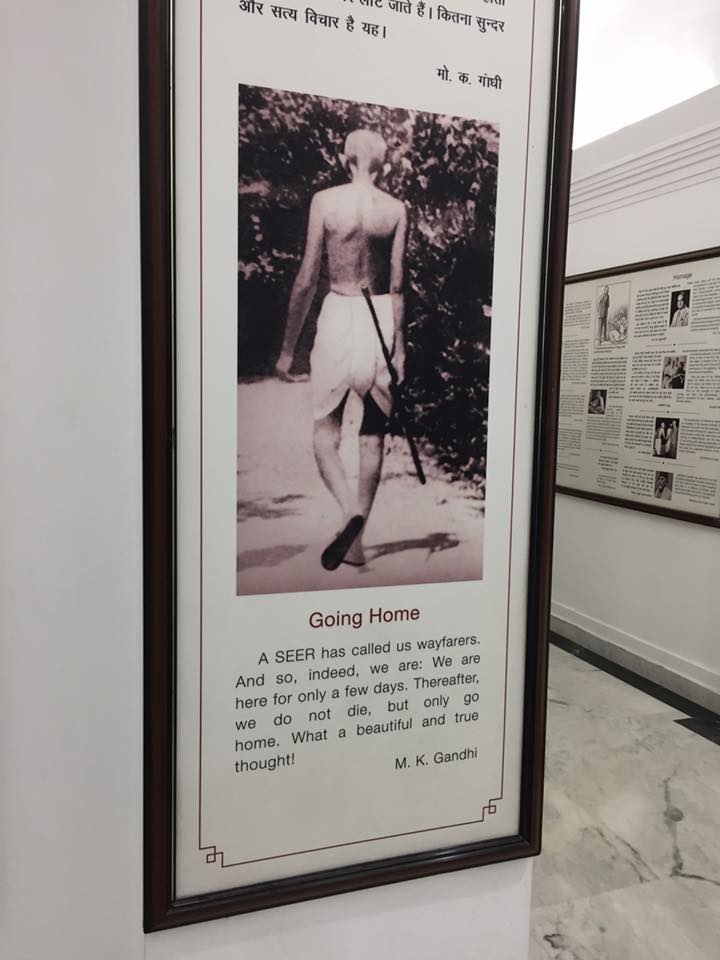
Ghandi – going home 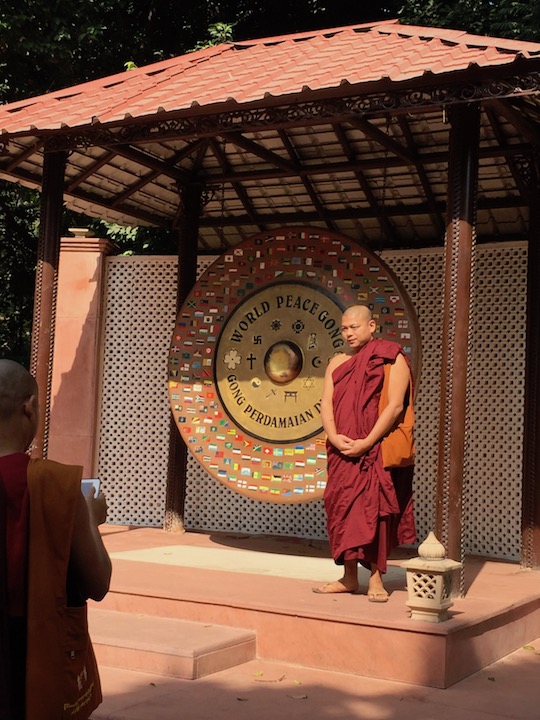
World Peace Gong at Ghandi’s Smriti (home)
Then we went to Connaught Place, another shopping Centre area, and had lunch at Hot Mess. Our tour guide was Amir, a handsome Muslim & professional cricket player
We did lots of walking and my tooth started hurting so I lay in back seat of bus while others went to see the Step well. I didn’t feel well and wanted to rest, so the bus dropped me at hotel @ about 4:30pm and the others went to market for more retail therapy.
Back at about 7pm and Marilyn took me back to the dentist for final check up. As I only took a small suitcase, I needed to buy another suitcase to fit my marble table and stand! The table (wrapped in layers of protective bubble wrap) is about 15in (40cm) x 17in (45cm) wide and 40 x 40 x (20cm) deep.I packed my 2 suitcases (still only about 20kg with a 30kg limit on Singapore Airlines) and we all went to bed early.
On 7 November we got up early at 6am to get to the airport for our flight to Singapore. It was too early to have breakfast was not available at hotel.
To be continued…
Part 4 HERE
More photos HERE
